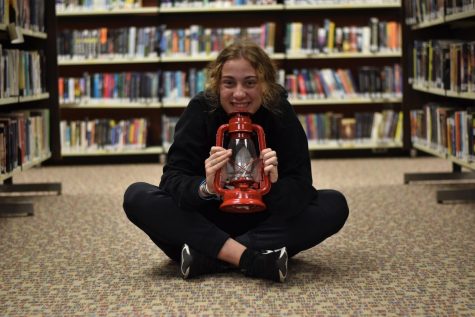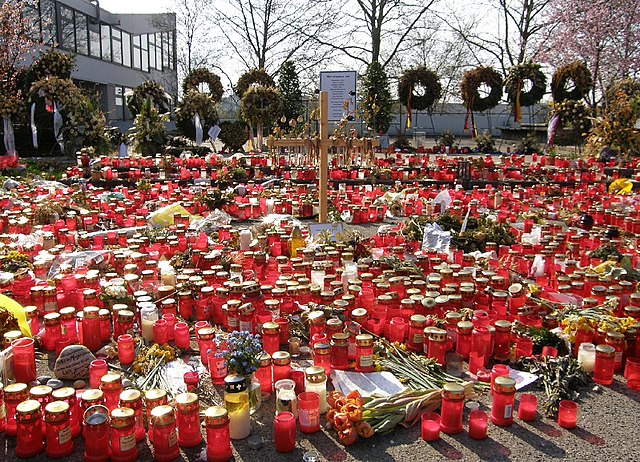The feedback loop: How mass media is creating the shootings they cover
Staff writer Jessica Baszuro takes a deep dive into the relationship between media and mass shootings, as well as the associated implications.
Candles and flowers typically mark the scene of a mass shooting
“Breaking news, just a few moments ago shots were fired in the Aurora theater, killing and injuring many, the count unkno—”
On July 20, 2012, news stations across the country made announcements similar to the headline written above, letting the country know of the distress and damage that James Holmes brought down upon an Aurora theater in Colorado; giving this man the attention that he was most likely seeking.
Media bases what they cover off of what gets attention. They write their headlines in a way that makes the reader want to know more, bringing more views to the article or video in question. Because of this, news sources will put the name or very specific details of a shooting into the title right away (often including the shooter’s name) hoping to get more people interested, thus bringing in more income with each click.
It might not seem like such a big deal on the outside looking in, but the truth is, the impact is a lot bigger than one would think. This can be seen when looking at how mass shootings are currently being covered, how it’s affecting communities and families all around the country, and better ways to cover them suggested by the families and friends of victims.
To understand the role of media in school shootings, it is important to examine how exactly are media sources covering mass shootings now. Well, as implied, sources are putting the spotlight on the shooter, often on the front page. They have long profiles of the shooter in the article putting the focus on them; not the victims, not the families, not the people witnessing the event, the shooter. Memorials and remembrances of the victims often come later.
Immediately after a shooting, sources are dedicating their amounts of airtime disproportionately. The amount of coverage time is not decidedly of the shooting itself, taking into account how big the other stories needing to be covered are.
According to a study done by Media Matters for America, “Lessons for the media following the worst mass shooting in modern U.S. history” done in November of 2017, heavy media coverage of very deadly mass shootings, such as the one in 2017 at a Las Vegas music festival, lasted for approximately a week. After that, it drastically dropped and the sources seemed to be moving on to bigger things.
This is not always the case, though, and coverage may last for much less time than that. In 2018, the Thousand Oaks shooting in California proved that media coverage changes depending on what is happening in the world. They will cover whatever the “biggest” story is. They have to think about what is important news that citizens need to hear about, and what is going to get the most views. This particular shooting was only on the “front page” for a day, pushed off by the California Fires despite it detrimental ending in 13 dead. This kind of spotlight-based media coverage brings with it many problems, but in these cases, it unfortunately ends in more victims of mass shootings.
According to the National Center for Health and Research in an article titled “Does Media Coverage Inspire Copy Cat Mass Shootings?,” large amounts of media coverage can inspire others to copy the inhumane actions in an attempt to get their chance in the spotlight. This is called the media contagion effect, and it is a very real thing, applying to suicides, terrorist attacks, and mass shootings. The reason behind this is that people are prone to do things that get them attention. It’s how they work. In the case of mass shooters, they are looking for the “fame” that the media so readily provides when bad things happen.
Dr. Adam Lankford from the University of Alabama has done many studies on media coverage of mass shootings as well as the motivations behind the shootings. In one of his journals published in September of 2017, “Don’t Name Them, Don’t Show Them, But Report Everything Else: A Pragmatic Proposal for Denying Mass Killers the Attention They Seek and Deterring Future Offenders,” Lankford wrote about the interviews he had with 24 mass shooters who openly admitted that they wanted fame, some even admitting that they contacted the media directly to acquire it.
Not only does providing them with this “fame” inspire more shootings, it also raises the death toll. According to the previously cited article above from the National Center for Health and Research, the shooter-to-be sees coverage of a mass shooting, as well as the number of victims, inspiring them to go through with the ideas already forming in their heads. In order to gain more publicity, they find themselves trying to kill more people than the last case in a sick way of proving themselves as “worthy.” Seeing what this sort of coverage does, adding to fuel to the fire and increasing the problem’s scope, it’s clear that something needs to change.
News sources can’t exactly ignore mass shootings, but they need to approach things a little differently, finding a middle ground between informing the public and keeping the shooter out of the spotlight.
The parents of a victim of the 2012 Aurora theater shooting that took place in Colorado started up an organization trying to get more people on board with this ideology. Their son, Alex, was killed shielding his girlfriend from the line of fire at the young age of 24. He was one of 12 dead and 70 injured during this incident.
NoNotoriety is the campaign designed by his parents, Tom and Caren Teves, for news sources to limit the name and face exposure of the criminal on-air, removing one of the motivating factors of mass killings. The founders believe it is important to balance the public’s right to information and their right to protection from potential harm, recommending a few of their ideas to do this successfully.
Their first idea is to put a limit on the number of times that the killer’s name is used. The suggested amount is once per piece of writing, taking care to never put it in the headline. They also suggest that sources report the facts on the individual, such as demographic and age, without providing any enlightening, but ultimately irrelevant, information such as where they’re from and what they were like (including images), unless the individual is on the run. Also recommended is using a very unflattering image for the times in which news sources need to share what the criminal looks like, such as a mug shot or an image of them being incarcerated. NoNotoriety’s final suggestion is to spend more time on the names, likenesses, and lives of the victims and their families, proving that their lives are more important than the actions of the killer.
Already, news sources from all around the country are taking approaches like this. A majority of Denver mass media outlets have already begun exhibiting NoNotoriety in their coverage of the Aurora theater shooting trial that inspired the campaign.
People Magazine also became the first major publication magazine to officially take on a No Notoriety policy as well as being shortly followed by The Florida Chapter of Society of Professional Journalists (SPJ). People Magazine chose to take a very simplistic and reserved approach to covering a shooting that happened at Oregon Community College back in 2015. They did not cover the specifics of the shooter and took the initiatives previously stated in an attempt to curb the problem.
As both the injury and death tolls rise, it is crucial that the media covering mass shootings in a helpful, rather than harmful way. This is seen when looking at how coverage is being done currently, the impact it has on future shootings, and ways suggested by friends and family of the victims to do it instead. In future coverage, more media sources should take an approach that involves telling the sorrowful stories of the lives that are lost instead of the life that stole.

Hi! My name is Jessica! I’m a junior who very occasionally writes or draws things for the lantern. I also can be found on the soccer field and on the...

